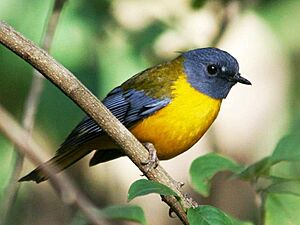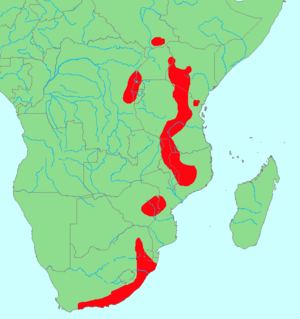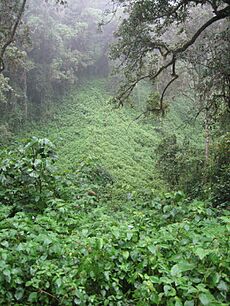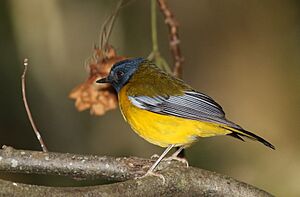White-starred robin facts for kids
Quick facts for kids White-starred robin |
|
|---|---|
 |
|
| Nominate race | |
| Conservation status | |
| Scientific classification | |
| Genus: |
Pogonocichla
|
| Species: |
stellata
|
 |
|
| approximate distribution | |
The white-starred robin (Pogonocichla stellata) is a small, colorful bird found in parts of Africa. It's also sometimes called the starred robin. This bird is the only species in its group, called Pogonocichla. There are about twelve different types, or subspecies, of this robin.
You can find white-starred robins in East and southern Africa. They live in forests, especially in mountains in the northern parts of their home range. Further south, they can live closer to the sea. This robin is easy to spot with its bright yellow chest and belly, a grey head with white spots near its eyes and throat, and bluish wings.
White-starred robins make many different sounds that change depending on where they live. They mostly eat insects, but they also enjoy some fruit. These birds defend their own areas and breed at certain times of the year. They build a dome-shaped nest and lay up to three eggs. The name Pogonocichla comes from Greek words meaning "beard" and "thrush," referring to the white spots on its face. The name stellata and "starred" also come from these spots, which look like little stars.
Contents
About the White-Starred Robin
The white-starred robin belongs to the Old World flycatcher and chat family, called Muscicapidae. This family used to be grouped with thrushes, but scientists now know they are different. The white-starred robin is unique because it's the only species in its genus, Pogonocichla. It is thought to be related to other African robins and robin-chats.
Scientists have identified about twelve different subspecies of the white-starred robin. These subspecies can look a bit different, especially when they are young. They also have different songs and calls, which helps scientists tell them apart.
Here are some of the recognized subspecies and where they live:
- Pogonocichla stellata stellata: Found in eastern and southern South Africa.
- P. s. transvaalensis: Lives in northern South Africa.
- P. s. chirindensis: Found in East Zimbabwe.
- P. s. orientalis: Lives in west, east, and south Tanzania, Malawi, and Mozambique.
- P. s. guttifer: Found near Mount Kilimanjaro, Tanzania.
- P. s. helleri: Lives in the Taita Hills, Kenya, and north-east Tanzania.
- P. s. intensa: Found in north and central Kenya and north Tanzania.
- P. s. elgonensis: Lives near Mount Elgon, Kenya and Uganda.
- P.s. ruwenzorii: Found in north-east Democratic Republic of the Congo, south-west Uganda, west Rwanda, and Burundi.
- P. s. pallidiflava: Lives in the Imatong Mountains, South Sudan.
Appearance
The white-starred robin is a small bird, about 15 to 16 centimeters (6 to 6.3 inches) long. It weighs between 18 and 25 grams (0.6 to 0.9 ounces). Female birds are usually a little smaller than males.
The most common type of white-starred robin has a slate-grey head with a white spot in front of each eye and another small one on its throat. Its back and part of its wings are green, while the rest of its wings are bluish-grey. Its tail is black with bright yellow stripes on the sides. The chest and belly are a bright yellow, and its legs are pinkish. Both male and female birds look alike. Their bill is wide and black, and it has special bristles around it that help them catch insects while flying.
Young white-starred robins look different from adults. They are dark brownish-black on top with golden spots, and yellow underneath with brown scales. Some young birds have a special "sub-adult" look that is dull olive on top and yellow with grey streaks on the chest. This look can last for up to two years.
Different subspecies can have slight differences in their colors. For example, some might have a paler yellow belly, a bronze-colored back, or an all-black tail.
Habitat and Migration

White-starred robins mostly live in moist evergreen forests, both old and new. They need forests with lots of shrubs and vines growing underneath the trees. They also live at the edges of forests, in pine tree farms, and even in gardens near forests. Sometimes, they are found in bamboo areas on mountains.
In the northern parts of their range, closer to the equator, they live in mountains at high elevations, usually between 1,500 and 2,200 meters (4,900 to 7,200 feet). Sometimes they go even higher. Further south in Zimbabwe, they usually stay below 1,300 meters (4,300 feet). In South Africa, they can even be found at sea level.
Some white-starred robins are migratory, meaning they move from one place to another. This is called "altitudinal migration," where birds move to lower elevations during the winter (April to September). This movement is more common in the southern parts of their range. For example, birds in Malawi might fly down to the shores of Lake Malawi, which is much lower. In South Africa, they might move as far as 120 kilometers (75 miles) from their breeding spots. Studies in Malawi show that male robins often stay in their breeding areas, while females move away for the winter.
Behavior
Voice and Calls
The calls and songs of the white-starred robin vary depending on where the bird lives. Both male and female robins sing a quiet song to mark their territory. This song is usually sung from low to the ground. During courtship, when birds are trying to find a mate, they sing a special call while flying. It sounds like a long "wiii wii wiii."
They also have a loud call they use to stay in touch with other robins or to warn of danger. This call is different for various subspecies. Some use a two-part sound like "too-twii", while others use a more complex, multi-part sound like "ter-whe dada wiiyoo".
Diet and Feeding
White-starred robins mainly eat insects and fruits. One study in South Africa looked at what these birds ate by checking their droppings. They found that beetles, moths, and ants were the most common foods. They also found parts of spiders, flies, caterpillars, and even small frogs.
Fruit was found in about a third of the samples. They eat fruits from various plants like Canthium, Ficus, and Rhus.
Reproduction and Life Cycle
White-starred robins breed during certain seasons, but the exact timing changes depending on where they live. For example, in the DR Congo, they breed from August to May. In South Africa, the breeding season is from September to December.

These robins are territorial breeders, meaning they defend a specific area for nesting. Their nests are unique because they are shaped like a dome. They build them from dead leaves, roots, moss, and vines, and line them with soft plant material. The nest is usually well hidden on sloping ground, often against a tree trunk or rock. The female builds the nest by herself, which takes about seven days.
They usually lay two to three eggs. Two eggs are more common in warmer, tropical areas, while three eggs are typical further south. Eggs are laid one each day, and the female starts sitting on them only after the last egg is laid. The female does all the incubation, which lasts about 16 to 18 days. After hatching, the chicks stay in the nest for about 13 to 15 days. They continue to rely on their parents for food and care for up to 42 days after hatching.
Sometimes, small animals like shrews and rodents raid their nests. Larger animals like civets and monkeys also sometimes attack nests. White-starred robin nests can also be targeted by "brood parasites." These are birds, like the red-chested cuckoo, that lay their eggs in another bird's nest, leaving the robin to raise the cuckoo chick.



